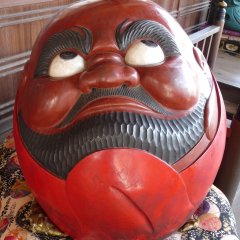It’s weird to be in Japan. It’s my first time and I really do feel like I’m on the other side of the world. Actually I am, after traveling across Russia on the Trans Siberia Railway and now across the Sea of Japan by ferry. A free shuttle bus takes me from the Eastern Dream into the centre of Sakaiminato. To my surprise, the bus drives on the right side of the road; by that, I mean the correct side, the left side, like in the UK.
As if to say a big konnichiwa (hello) and to my surprise there are colourful models of cartoon characters all over town. Every few metres along the main road, on rocks on the pavement cartoon caricatures have been placed. There are huge colourful comic posters on the walls of the buildings and the station too. There are only a handful of people around this early in the morning, but one of them is a man dressed in a cartoon outfit, walking around, greeting everyone. It makes me smile when he shakes my hand. Welcome to Japan.
He is the cartoon character, Kitarō. GeGeGo no Kitarō is a well-known cartoon series in Japan that has been adapted for TV, film and animation. Its creator, manga artist Shigeru Mizuki, was raised here in Sakaiminato. Manga are comics created in Japan, by the Japanese and in Japanese language. Mizuki lost his left arm in World War II and, as a prisoner of war in Papua New Guinea, he was sheltered by a local tribe, the Tolai. His experiences of the atrocities of war have shaped the contents of his work. His creation, Kitarō, is a three hundred and fifty year old boy, a yokai (a supernatural monster), and, apart from his decayed father, he is the last living member of his ghost tribe. Kitarō has no left eye, so his hair covers the empty socket. He fights for peace between the two races, humans and yokai, with an assortment of strange weapons.
Fortunately Kitarō allows me to leave Sakaiminato safely by train. Each train is decorated with pictures of the characters in the GeGeGo no Kitarō series. I board the Medama Oyaji train. Medama Ooyaji is Kitaro's father, who was once a fully formed adult ghost, but is now reborn as an anthropomorphic version of his own eyeball. On board, the driver and conductor add to the cartoon feel, dressed in full uniform with peaked caps and white gloves. Even the announcements for the stations are in animated voices. I feel like I’m in Disneyland, but it’s a wonderfully happy and colourful welcome to Japan. Unfortunately, not all the trains or the cities in Japan are like this. I wish they were.




























